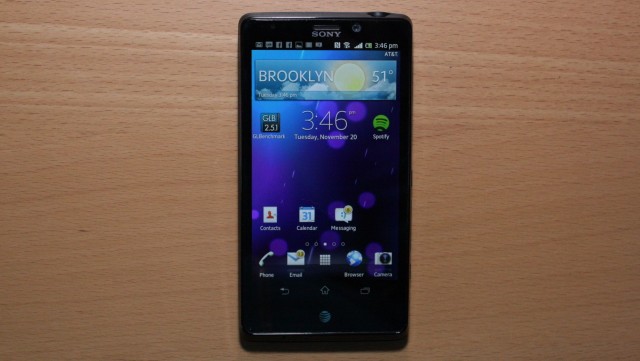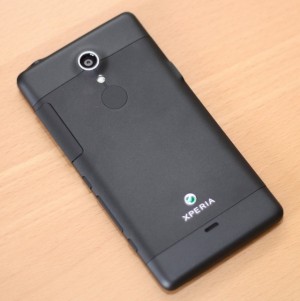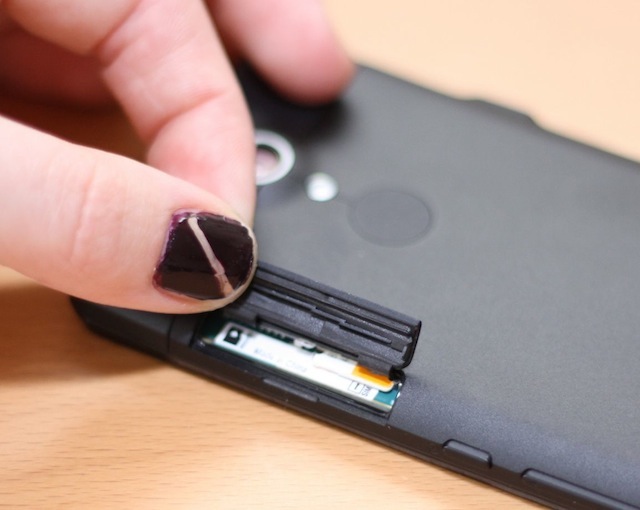
Sony's latest handset's claim to fame is its appearance in the latest Bond movie, Skyfall, handled by no lesser a man's man than Daniel Craig himself. The phone actually appears for only a handful of seconds, while Bond toys with it alone at a bar (presumably, like every loner out there, to keep other people from talking to him). But while the choice of celebrity association is beyond reproach, we found many of its features fall short of the power and ease of use implied by its honorific.
The Xperia TL back has a very subtle concave shape. When it's laid on its back on a table, only the bottom edge and the rear camera touch. The back is slightly rubberized, soft, and feels comfortable to hold in portrait orientation. (But if you so happen to hold it in landscape, it can feel a little like a boomerang.) One of the finer points of its design is the haptic feedback: shallow, tight vibrations that ring through the phone when we type or select items.




Aping a layout more typical of Windows Phone handsets, the sleep button is in the center of the right hand side, above the volume rocker and hardware camera button. A headphone jack is on the top right corner and the microUSB port is embedded on the left-hand side. On the upper right side, a trapdoor flips open to reveal the SIM and microSD slots. The obvious undocumented storage use cases here: appropriately-shaped cyanide pills, tiny spare GPS radio for concealing about your person when you know your phone will be confiscated by Soviets, breath strips.
Per the phone's heritage, it comes out of the box with the iconic gun-barrel image as the home screen background and a default notification sound of James Bond-y twanging guitars. A few other Bond elements come preloaded: more backgrounds with a gold-coated woman holding a silenced PP7 or Daniel Craig brooding out a window; stills from Skyfall in a photo album; a James Bond theme ringtone.
If you are disenchanted with the default Play Music app, Sony places a Walkman-branded one front and center to manage your music catalog. This, sadly, improves the experience in no appreciable way. In theory, the app can connect to your Facebook account and show music that friends have shared, but it appears to require that those friends share that music through their own Walkman-branded app. Dare to dream, Sony.
The Xperia TL's 4.6-inch 1280x720 screen is very crisp, and text throughout the OS looks great. By default, pages sometimes render strangely in the browser with very tiny text that only flows across half the screen (so once you zoom in, you have edge-to-edge text that's a readable size). The phone is running Android 4.0 Ice Cream Sandwich—not the latest Android OS by a few months now, though Sony promises Jelly Bean is coming.
The Xperia TL boasts a 13-megapixel camera on the rear that can record 1080p video. Many phone manufacturers have made a point of improving their camera apps over the last year, adding features like continuous background shooting that allows users to scroll back and forward in time for a better shot or near instantaneous shot-to-shot lags.



The Xperia TL's camera has no such improvements; shot-to-shot times remain a bit slow and the app itself is pretty bare-bones beyond the usual Android offerings (panoramas, smile detection, self-timer, and so on). Still, the Xperia TL turns out some decent photos even in low-light scenarios. We found that it can't resolve bright lights as well as the iPhone 4S's camera can.
The speaker on the Xperia TL does not get very loud, even at the highest volume setting, though there is little distortion. We noticed that at lower volumes the speaker could sound a bit muffled and the bass was weak, but otherwise it was adequate. Like so many phones, it's somewhat inconveniently placed on the back at the bottom center, so your hand will more or less always be covering it. Actual phone call quality is likewise fine, but not mindblowing.

Inside the Xperia TL is a 1.5GHz dual-core Krait CPU, Adreno 225 GPU, 1GB of RAM, 16GB of storage, and a 4G LTE chip. When it comes to performance, the Xperia TL delivers middling-to-low numbers compared to its contemporaries. It scores around 1600 in the Sunspider Javascript benchmark. It fares slightly better with Google's Octane benchmark, with a score of 1430 compared to the Optimus G's 1627, the Galaxy S III's 1645, and the iPhone 5's 1298 (the phone's Javascript engine does not support typed arrays, so the benchmark returns an "incomplete" message at the end).
The phone is more middle-of-the-pack in GLBenchmark: 13 and 28 frames per second in the offscreen Egypt HD and classic tests, and 20 and 50 frames per second for the offscreen test. This puts it in roughly the same performance league as the Galaxy S III, but far off from the Optimus G and the iPhone 5. So not Bond.



Sony quotes the Xperia TL's battery at 1850mAh, or about seven hours of talk time, 16 hours of music playback, five hours of video, or 450 hours of standby—not the most reassuring of figures. But in our video tests, we found that the phone actually performed better than estimates, with about six hours and 15 minutes of movies at 50 percent brightness and 100 percent volume. Turning the brightness all the way up would temper that figure a bit, but the screen looks sufficiently bright in most situations when only turned up halfway.
In regular use, with some moderate e-mailing, messaging, Web browsing, the occasional app download, and short YouTube-watching session, we found the phone was fresh out of battery by the end of the work day. It lasted between eight and nine hours. Android phones are still mixed bags when it comes to battery life, so the Xperia TL isn't alone in this offense, but we think buyers can expect to be annoyed by the insufficient battery.

It's hard to buy this phone as The Bond Phone when the price is set at a modest $99.99 with two-year contract on AT&T, but we played along for a bit to see if there was any substance behind the name. Sadly, the Bond Phone holds only so-so performance, a decent but not-great camera, and an ambitious body design that ends up being more form than function. The only Bond that Q might bequeath such a modest handset to is Peter Sellers.
The good:
- HD screen is crisp, bright, and looks great.
- Phone is generally speedy in basic operations: OS navigation, browsing, messaging.
- Haptic feedback feels nice.
- Camera takes good photos.
The bad:
- Graphics and performance stats are middling.
- Battery life is too short.
- Bond accents (ringtones, text tones, backgrounds, included content) are a little cheesy and functionally out of step with the times we live in.
The ugly:
- Given how the phone is calibrated relative to other offerings, the Bond association is at best nonsensical, at worst an insult to the Bond-quality technology legacy.
reader comments
51